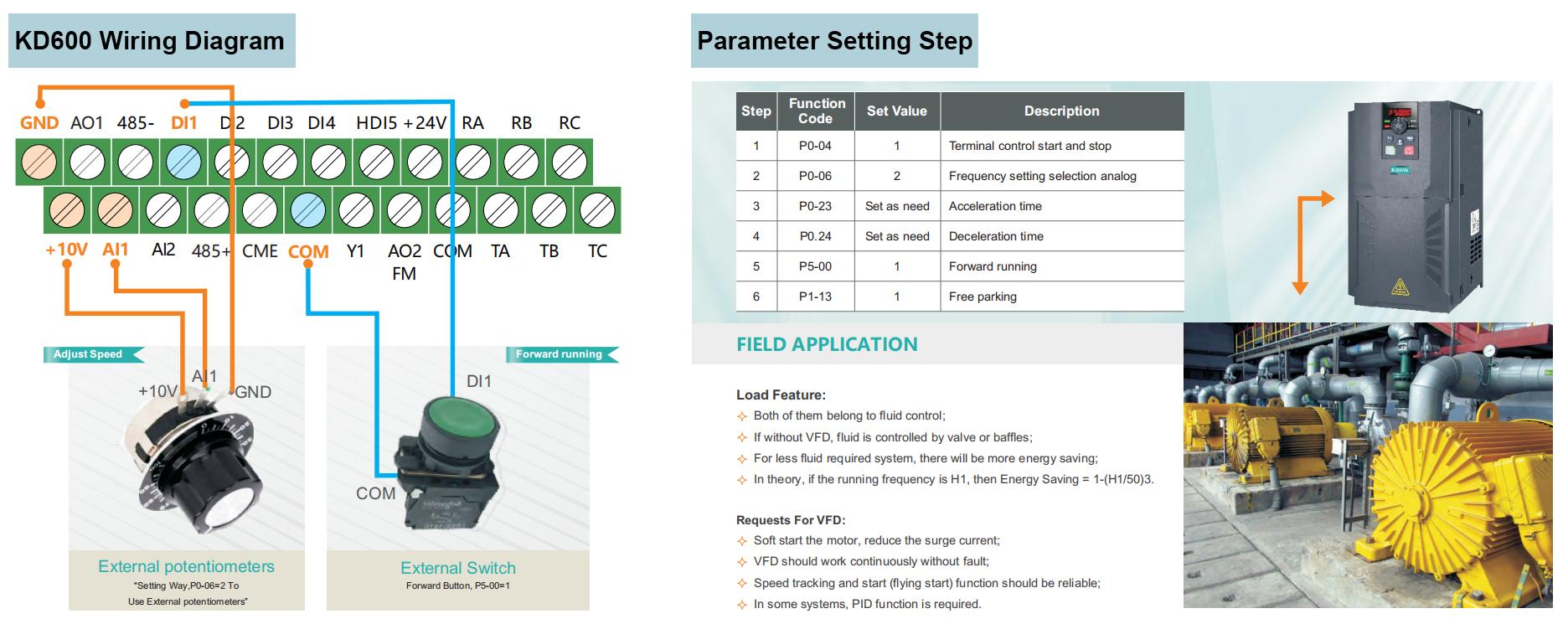Case Background
A factory's pump system needed optimization to improve energy efficiency and control precision. Traditional pump systems typically control fluid through valves or baffles, but this method can lead to energy waste in systems requiring less fluid. To achieve higher energy efficiency and reduce energy consumption, the factory decided to implement the KD600 series inverter (VFD) to control the pump operation.
Requirements for the Inverter
Soft Start Function: To reduce surge current when the motor starts.
Continuous Fault-Free Operation: To ensure the inverter operates stably throughout the process.
External Switch Control: To control the start and stop functions using an external switch.
External Potentiometer Control: To adjust the speed using an external potentiometer.
PID Function: To maintain system stability and precision in cases requiring accurate control.
Field Application and Parameter Settings
To meet the above requirements, the engineers configured the KD600 inverter with the following parameter settings:
Start and Stop Control: Set P0-04 to 1 for terminal control.
Frequency Setting Selection: Set P0-06 to 2 for analog input.
Acceleration Time: Set P0-23 according to system requirements.
Deceleration Time: Set P0-24 according to system requirements.
Forward Running: Set P5-00 to 1.
Free Parking: Set P1-13 to 1.
PID Control: Enable PID function to automatically adjust for precise control of flow and pressure when needed.
Wiring Diagram
External Potentiometer: Used for speed adjustment, connected to AI1 and GND, 10V terminals, with P0-06 set to 2.
External Switch: Start button, connected to DI1 and COM terminals, with P5-00 set to 1.
Practical Application Effects
By using the KD600 inverter to control the pump, the factory achieved the following improvements:
Energy Savings: The inverter adjusts motor speed based on actual demand, resulting in significant energy savings when running at lower frequencies.
Smooth Start: The soft start function reduces mechanical shock and current surge when the motor starts, extending the equipment's lifespan.
Precise Control: The external potentiometer allows for precise speed control, meeting the requirements of different operating conditions.
PID Function: In applications requiring precise control, the PID function helps maintain system stability and control precision, ensuring the flow and pressure are always within the set range.
The theoretical energy-saving formula when the running frequency is H1 is: Energy Saving = 1 - (H1/50)3. This indicates that efficiency improves significantly when operating at lower frequencies.
Conclusion
By implementing the KD600 series inverter, the factory's pump system not only improved operational efficiency and control precision but also achieved substantial energy savings. This case demonstrates the widespread applicability and significant potential of inverters in fluid control systems. Using an inverter to control the pump can optimize system performance, significantly reduce operational costs, and enhance the reliability and lifespan of the equipment. The inverter wiring diagram and parameter settings provide specific technical support to achieve these goals.
Through this approach, the factory not only met its energy-saving and emission reduction targets but also increased production efficiency, showcasing the superior performance and economic benefits of the KD600 inverter in pump applications. The PID function provides higher control precision in specific applications, further enhancing the overall system performance.





 Address: Building 1#, Auto Science and Technology Park, No. 13, Huanlian Road, Changsha High-tech Development Zone, Hunan Province
Address: Building 1#, Auto Science and Technology Park, No. 13, Huanlian Road, Changsha High-tech Development Zone, Hunan Province  +86 - 19924552818 (Whatsapp)
+86 - 19924552818 (Whatsapp)






